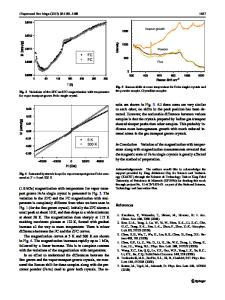Crystal structures and magnetic properties of two isomorphic nickel(II) and cobalt(II) coordination polymers-based nitro
- PDF / 1,117,552 Bytes
- 8 Pages / 595.276 x 790.866 pts Page_size
- 75 Downloads / 375 Views
Crystal structures and magnetic properties of two isomorphic nickel(II) and cobalt(II) coordination polymers‑based nitrogen‑heterocyclic tricarbolylate ligands Yufang Wang1 · Shan Li1 · Liya Wang2 Received: 13 February 2020 / Accepted: 10 June 2020 © Springer Nature Switzerland AG 2020
Abstract 5-(3,4-Dicarboxylphenyl) picolinic acid (H3dppa) was applied as a new building block for the synthesis of two isomorphic coordination polymers, namely [Ni1.5dppa(H2O)3]n·nH2O (1), [Co1.5dppa(H2O)3]n·nH2O (2). Two compounds were generated by a hydrothermal self-assembly method using the corresponding metal(II) acetates and H 3cppa ligand. Structure analysis reveals that compounds 1 and 2 are isomorphic both featuring a two-dimensional wave structure and are finally extended into the three-dimensional supramolecular architecture though hydrogen bonding interactions. Magnetic susceptibility measurements indicate that domain a weak ferromagnetic exchange coupling between the adjacent Ni(II) centers in 1, and a weak antiferromagnetic coupling between Co(II) ions in for 2.
Introduction The design of functional materials is a great challenge for synthetic chemists. Coordination polymers (CPs) have been significantly explored as new solid-state materials and have become a hot research topic for the scientists worldwide in the past two decades [1–5]. Coordination polymers (CPs) are being considered for a variety of applications such as luminescence and sensing, heterogeneous catalysis, gas storage/ separations, nonlinear optics, magnetic applications, and so on, due to their tunable structures and excellent properties [6–10]. However, the structures and properties of the CPs are difficult to be controlled, because they are influenced by many factors such as the configuration of ligand, types of metal ions, ratio of metal center to ligand, pH value, reaction temperature and solvent preference [11–14]. * Yufang Wang [email protected] * Liya Wang [email protected] 1
College of Chemistry and Chemical Engineering, and Henan Key Laboratory of Function‑Oriented Porous Materials, Luoyang Normal University, Luoyang 471934, People’s Republic of China
College of Chemistry and Pharmaceutical Engineering, Nanyang Normal University, Nanyang 473061, People’s Republic of China
2
In recent years, carboxylic acid or pyridyl ligands have been extensively studied. However, the research of polycarboxylic acids with additional pyridyl functional binding sites has remained largely unexplored in the assembly of coordination polymers. Pyridylcarboxylates represent a type of commonly used multidentate building blocks, which possess the asymmetric backbones and two dissimilar functional groups [15–18]. In this regard, 5-(3,4-dicarboxylphenyl) picolinic acid (H3dppa) is one nitrogen-heterocyclic polycarboxylate ligands which possess a pyridyl ring and three carboxyl groups. Rotating of the C–C single bond between pyridyl and phenyl rings can facilitate a conformational adaptation. In addition to above, this ligand is thermally stable and has sev
Data Loading...











